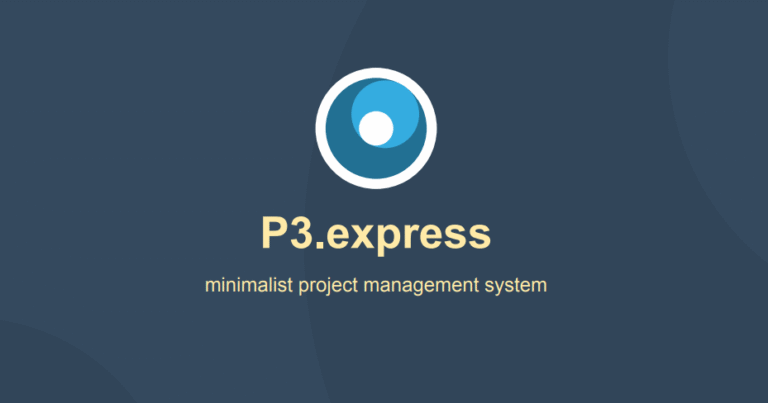Streamlining Project Delivery: A Practical Guide to the P3.express Framework
In today’s competitive landscape, project teams are often caught between two extremes: chaotic, unstructured work or rigid, bureaucratic methodologies. The former leads to missed deadlines and uncontrolled scope creep, while the latter buries teams in administrative overhead, stifling the very progress it’s meant to ensure. But what if there was a middle ground? A system that provides robust project governance without the unnecessary weight?
Enter P3.express; a minimalist, cyclical, and highly practical project management framework. It’s designed for clarity, efficiency, and results. This guide offers a comprehensive deep dive into the P3.express system, exploring its core philosophy, operational cycles, and how you can implement it to foster a culture of accountability and successful delivery. For organisations seeking to enhance their project capabilities, this could be the key.
What Exactly is P3.express? A No-Nonsense Definition
P3.express is a free, open-source project management system that focuses exclusively on the essential elements required for successful project delivery. It strips away the complex, often optional, components of larger standards like the PMI PMBOK® or PRINCE2®, providing a lean and intuitive workflow that is easy for everyone, from the project team to the steering committee, to understand and follow.
It acts as a simple, logical overlay on the actual work of the project, ensuring that management activities happen consistently and effectively.
Who Benefits Most from P3.express?
- Small to Medium-Sized Projects: Where a full-scale methodology would be overkill and counterproductive.
- Organisations New to Formal PM: It serves as a perfect entry point to structured project management without a steep learning curve or costly certifications.
- Resource-Constrained Teams: The low administrative burden allows teams to focus their limited time on value-adding tasks rather than extensive documentation.
- PMOs Seeking a Scalable Standard: It can be used as a baseline methodology for simpler projects within a larger portfolio, complementing more robust frameworks used for complex initiatives.
The Core Philosophy: Why Simplicity Drives Success
The power of P3.express lies in its foundational principles. These aren’t just abstract ideas; they are practical guidelines that shape the entire project lifecycle and promote a culture of trust and accountability.
Key Principles of the Framework
- A Focus on Practicality: Every single activity and document within P3.express is designed to directly support decision-making and project flow. There are no “just in case” processes that don’t add immediate, tangible value.
- A Rhythmic, Cyclical Approach: The entire project is managed through repeating weekly and monthly management cycles. This creates a predictable rhythm, or “heartbeat,” ensuring that planning, monitoring, and stakeholder communication become ingrained habits.
- Human-Centric Design: The system is built around people. It emphasizes clear, simple communication and uses visual process maps that are intuitive and easy to follow, reducing ambiguity and fostering better team collaboration.
- Continuous Improvement is Built-In: The cyclical nature, combined with end-of-cycle reviews, naturally embeds lessons learned into the project as it progresses, not just at the very end when it’s too late to make a difference.
The Engine Room: Deconstructing the P3.express Management Cycles
The operational heart of P3.express is its dual-cycle structure. This ensures that strategic oversight and on-the-ground execution are always in sync, allowing for rapid course correction and preventing surprises.
The Monthly Cycle: Maintaining Strategic Alignment
- Initiation (Month 1 Only): The Project Manager and Sponsor work together to create the initial project description and business case, securing formal approval to proceed.
- Monthly Management: In the final week of each month, the Project Manager prepares a concise progress report and updates the key project registers (e.g., risk log, issue log).
- Project Direction: The Project Sponsor and Steering Committee review the report, make critical decisions, provide guidance, and formally approve plans for the next cycle. This keeps them accountable and involved.
The Weekly Cycle: Driving On-the-Ground Execution
- Team Coordination: The Project Manager facilitates a weekly coordination meeting to review the progress of ongoing tasks and plan the week ahead in detail.
- Task Execution: The team works on their assigned activities, with a clear understanding of the immediate priorities.
- Monitoring and Follow-Up: Throughout the week, the Project Manager monitors progress against the plan, helps remove impediments, and ensures the team is on track for the end-of-month review.
Putting it into Practice: Tips for a Smooth Implementation
Adopting any new framework requires a thoughtful approach. Here are some practical steps to ensure a successful rollout of P3.express in your organisation.
- Start with a Pilot Project: Select a suitable, low-to-medium complexity project to pilot the framework. This allows the team to learn the cycles in a controlled environment and build a success story.
- Clearly Define Roles and Responsibilities: While the framework is simple, roles must be clear. Ensure everyone understands the responsibilities of the Project Manager, the Project Sponsor, and the team members within the weekly and monthly cycles.
- Leverage the Free Resources: The official P3.express website provides free access to the entire manual, templates, and visual guides. Use these standardised tools rather than reinventing the wheel.
- Focus on the “Why,” Not Just the “How”: Communicate the benefits of this lean approach to the team and stakeholders. When they understand that it’s designed to reduce their administrative burden and help them focus on results, you will get much stronger buy-in.
Final Thoughts: Is P3.express the Right Fit for Your Team?
P3.express is not a silver bullet, but it is a powerful, logical, and incredibly effective tool for the right environment. By stripping away complexity and focusing on a consistent rhythm of communication and control, it empowers teams to deliver results with greater predictability and less friction.
If your organisation is looking to enhance its project delivery capabilities without getting bogged down in a heavyweight framework, P3.express offers a clear, sustainable, and proven path to success. For expert guidance on implementing the right project management methodologies for your business, explore our Project Management services.


